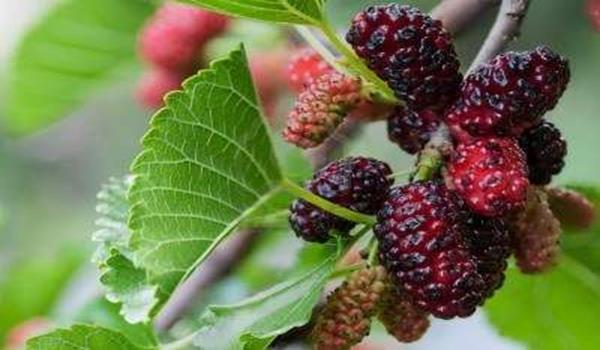Refreshingly succulent, tart and sweet mulberries are indeed rich in numerous health benefiting flavonoid phyto-nutrients. Botanically, the berries are obtained from the silkworm tree belonging to the Moraceae family within the genus: Morus. Scientific name: Morus nigra. L. In Spanish, the berries are known as moras.
More than hundred species of morus exist. In taxonomy, species generally are identified not by the color of the fruits (berries) but by the color of flower buds and leaves. So, a morus plant can exhibit different color berries (black, purple, red, white, etc.) in the same plant.
Mulberries are large, deciduous trees native to warm, temperate, and subtropical regions of Asia, Africa, and the Americas. Technically, the mulberry fruit is an aggregation of small fruits arranged longitudinally around the central axis as in blackberry or loganberries. Each fruit measures 2-5 cm long. In most species, these berries are purple-red when ripen; however, they can be white, red, purple or multiple colors in the same fruit.
Health benefits of mulberries
- Delicious, fleshy, succulent mulberries are low in calories (just 43 calories per 100 g). They contain health promoting phyto-nutrient compounds like polyphenol pigment antioxidants, minerals and vitamins that are essential for optimum health.
- Mulberries have significantly high amounts of phenolic flavonoid phytochemicals called anthocyanins. Scientific studies have shown that consumption of berries have potential health effects against cancer, aging and neurological diseases, inflammation, diabetes, and bacterial infections.
- The berries contain resveratrol, another polyphenol flavonoid antioxidant. Resveratrol protects against stroke risk by altering molecular mechanisms in the blood vessels; reducing their susceptibility to damage through decreased activity of angiotensin (a systemic hormone causing blood vessel constriction that would elevate blood pressure) and increased production of the vasodilator hormone, nitric oxide.
- In addition, these berries are an excellent source of vitamin-C (36.4 mg per 100, about 61% of RDI), which is also a powerful natural antioxidant. Consumption of foods rich in vitamin-C helps the body develop resistance against infectious agents, counter inflammation and scavenge harmful free radicals.
- Further, the berries also contain small amounts of vitamin A, vitamin E and in addition to the above-mentioned antioxidants. Consumption of mulberry provides another group of health promoting flavonoid polyphenolic antioxidants such as lutein, zea-xanthin, ß-carotene and α-carotene in small but notably significant amounts. Altogether, these compounds help act as protect from harmful effects of oxygen-derived free radicals and reactive oxygen species (ROS) that play a role in aging and various disease processes.
- Zea-xanthin, an important dietary carotenoid selectively concentrates into the retinal macula lutea, where it thought to provide antioxidant functions and protects the retina from the harmful ultraviolet rays through light-filtering actions.
- Mulberries are an excellent source of iron, which is a rare feature among berries, contain 1.85 mg/100 g of fruits (about 23% of RDI). Iron, being a component of hemoglobin inside the red blood cells, determines the oxygen-carrying capacity of the blood.
- They also good source of minerals like potassium, manganese, and magnesium. Potassium is an important component of cell and body fluids that helps controlling heart rate and blood pressure. Manganese is used by the body as a co-factor for the antioxidant enzyme, superoxide dismutase.
- They are rich in B-complex group of vitamins and vitamin K. Contain very good amounts of vitamin B-6, niacin, riboflavin and folic acid. These vitamins are function as co-factors and help body in the metabolism of carbohydrates, proteins and fats.
Selection and storage
Black mulberries in particular are more flavorful and tasty than their fellow white, and red varieties. Their peak season is May through August while the other two varieties are readily available by late spring.
In the stores, look for fleshy berries flavorful and heavy in hands. Avoid bruised, bleeding and sunken berries.
Once at home, preserve them in the zip pouch unwashed inside refrigerator where they stay fresh for up to a week. Mulberries spoil rather quickly. To eat, wash the berries in cold water in a container (bowl) instead of in running water. This way, you avoid injuring them. This method also brings the berries to room temperature and enhances their flavor and taste.
Preparation and serving methods
After cleaning, gently pat them dry using soft cloth. Take care not to squeeze or press the berries else they will stain cloth, hand, etc. Then, trim away its stem end by simply pinching off with fingers or either using a small scissors or paring knife.
The berries have found their unique place in the kitchen, be it a simple mulberry pie or somewhat more complicated mulberry wine; they are favored in variety of recipes.
Here are some serving tips:
- Fresh mulberries are generally eaten as they are without any additions.
- They mix well with other berry salads.
- They can be a great snack between meals.
- Mulberries are favored in jams, jellies, tart syrups, etc.
- Dried mulberries can be used in pie fillings, mulberry muffins, cookies, cakes, etc.
- They are used in ice-creams, smoothies and yogurt as in strawberries, raspberries, etc.










